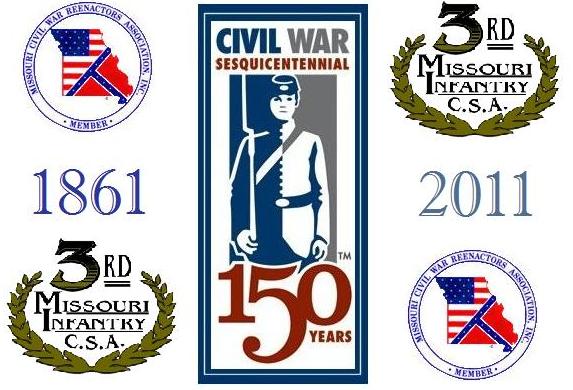1861/2011
Missouri State Guard Impression
The 2011 reenacting year will see 150th anniversary event in Missouri at Wilson's Creek, Lexington, Booneville, Cole Camp, Carthage, and others. All of these events with 1861 dates and 150th annv. dates in 2011 will be a Missouri State Guard impression. This impression will be the guideline for all 150th avvn. events in Missouri in 2011. The Missouri State Guard impression is that of a civilian solider. Most of these men came straight off the farm, or right out of the city with little to no military experience. These men of the Missouri State Guard did not officially join the regular Confederate Army until 1862, but answered the call to arms of Governer of Missouri, Claiborne Fox Jackson, in early 1861 after the Missouri State Legislature passed the "Military Bill" on May 11, 1861, in direct response to the Camp Jackson Affair in St. Louis the previous day. The final version of the act approved on May 14 authorized the disbanding of the old informal Missouri State Militia and reforming it as the Missouri State Guard to resist a feared invasion by the Union Army.
Recruits for the Missouri State Guard began to quickly assemble in Jefferson City in mid-May. However, after an agreement, the Price-Harney Truce on May 20 between Price and the Federal department commander William S. Harney, the call up was halted. On May 30, Harney was relieved and Nathaniel Lyon took command of the department. On June 11, a meeting to resolve some disagreements resulted in the collapse of the truce. Price and Jackson fled St. Louis for Jefferson City. The next day Governor Jackson called for 50,000 volunteers to defend
Again these men came straight off the farm, or out of the city with little to no military experience. As such they arrived ready to enlist in the Guard dressed in what they wore from day to day as
Clothing
Coats / Over-shirts:
Civilian Over-shirt (made from wool, wool jean, cotton, linen, or cotton jean)
Civilian Over-shirt "Battle Shirt" (made from wool, wool jean, cotton, linen, or cotton jean) trimmed with velvet, wool, or worsted wool tape
Civilian Sack Coat (made from wool, wool jean, or linen)
Civilian Frock Coat (made from wool broadcloth or linen)
Militia Jacket (with documentation)
Vest (there is one photo of MSG wearing vest with no jacket)
Trousers:
Civilian Overalls (made from cotton or wool jean)
Civilian fly or fall front trousers (made from linen or wool broadcloth)
Civilian workman’s trousers (made from wool, wool jean or cotton jean)
Headgear:
Civilian slouch hate / Civilian bell crown or straight top-hat / Straw hat
Civilian wheel cap / Mexican war forage cap / A few federal kepisShirts:
Civilian cotton, linen, or wool shirt / Printed cotton shirt
Drawers:
Civilian pattern (made from cotton or muslin)
Socks:
Wool or cotton knit civilian pattern socks
Equipment
Cartridge Box:
Civilian shot-bag / Haversack / M1839 Cartridge Box / M1808 Cartridge Box
Belt:
Civilian double or single roller buckle / Militia web belt
No Confederate belts
Cap Box:
Mexican War Pattern Box / Militia Pattern Box / Carry caps in pocket
NO Confederate cap boxes
Bayonet Scabbard:
Mexican War Pattern / Militia web sling pattern / Go with our a bayonet and scabbard
NO Confederate patterns
Haversacks:
Mexican War Pattern / Cotton or linen civilian pattern / Tapestry or carpet bag haversack
Canteen:
Wooden canteen / Tin drum canteen / Civilian glass bottle / Gourd Canteen
Mexican War Pattern wood canteen
Bed-rolls / Knapsacks:
Blanket or quilt bell-roll / Mexican War knapsack (not Confederate copies of this pattern)
Militia Hard Pack
Weapons:
Civilian hunting rifle (percussion or flintlock) / Civilian double or single barrel shotgun
M1795 Springfield flintlock / M1816/1822 Springfield flintlock or conversion
M1842 Springfield Musket / Mississippi Rifle (M1841)
Civilian or Military single shot pistols / Civilian or Military revolvers (per 1860 models)
Farm tools / Pikes / Wooden clubs
M1861 Springfield or Enfield (if thats all you have)

